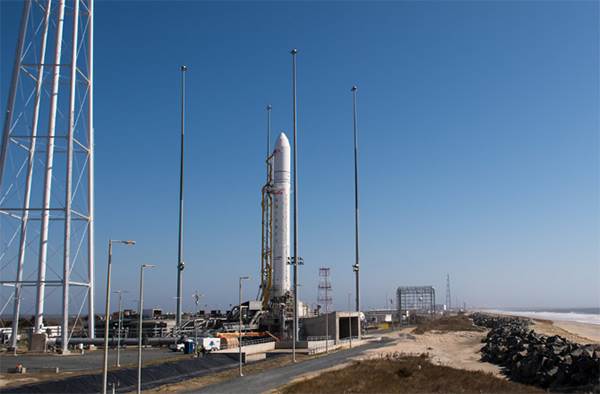Private Rocket Ready for Critical Launch Test
Hoping to help fill the gap left by the space shuttles’ retirement nearly two years ago, a second company plans to demonstrate a new space transportation system for sending cargo to the International Space Station.
Orbital Sciences Corp’s Antares rocket is due to lift off between 5 and 8 p.m. EDT on Wednesday from a new commercial spaceport on Wallops Island, Virginia.
The 13-story rocket is by far the largest vehicle to blast off from Wallops, better known for launching small boosters and balloons that don’t fly fast enough to go into orbit around Earth.
The Orbital Sciences Corporation Antares rocket is seen on the Mid-Atlantic Regional Spaceport (MARS) Pad-0A at the NASA Wallops Flight Facility, Tuesday, April 16, 2013 in Virginia.
“A lot of people say that the American space program is in decline. Well you only have to go a couple of miles down the road to see it on the rise, literally, on the pad,” Phil McAlister, who oversees commercial spaceflight development for NASA, told reporters at a prelaunch press conference at the agency’s Wallops Flight Facility.
If successful, Orbital Sciences will join Space Exploration Technologies (SpaceX) in flying cargo to the station, a multinational research outpost, staffed by rotating crews of six astronauts, that flies about 250 miles above Earth.
Together, the companies have contracts worth $3.5 billion to keep the station stocked with food, clothing, supplies and science experiments.
Wednesday’s test flight is intended to demonstrate Orbital Sciences’ Antares rocket. The Cygnus cargo capsule will debut on second flight this summer.
Antares, like SpaceX’s Falcon 9 booster, consumes liquid fuel, but there the similarities end. SpaceX designed nearly everything on its rocket in-house. Orbital, which started as a commercial space company in 1982, turned to well-established aerospace contractors to supply the rocket’s engines and support systems.
The differences between SpaceX’s Dragon and Orbital Sciences’ Cygnus capsules are even more pronounced.
Dragon, which SpaceX is upgrading to carry people as well, is designed to return to Earth. Cygnus, like the Russian, European and Japanese cargo ships that also service the station, burns up in the atmosphere after it departs.
But the company is developing plans to keep a Cygnus in orbit for up to a year to host science instruments, sensors and other experiments.
Cygnus is larger than Dragon and can carry about 50 percent more cargo. Orbital Sciences’ agreement with NASA is for eight flights to the station, for which it would be paid $1.9 billion. SpaceX was hired for 12 cargo runs under a $1.6 billion contract.
NASA says its freighters are not in direct competition with each other.
“We saw after Columbia how tenuous our lifeline is, our toehold to low-Earth orbit and the International Space Station,” McAlister said, referring to the 2003 shuttle accident that claimed the lives of seven astronauts.
“That one tragic accident made it really very challenging to maintain (the station) during that very difficult period of time. We are in such a better situation today — and about to be even better with the debut of this capability,” McAlister said.
Apr 16, 2013 07:24 PM ET by Irene Klotz












